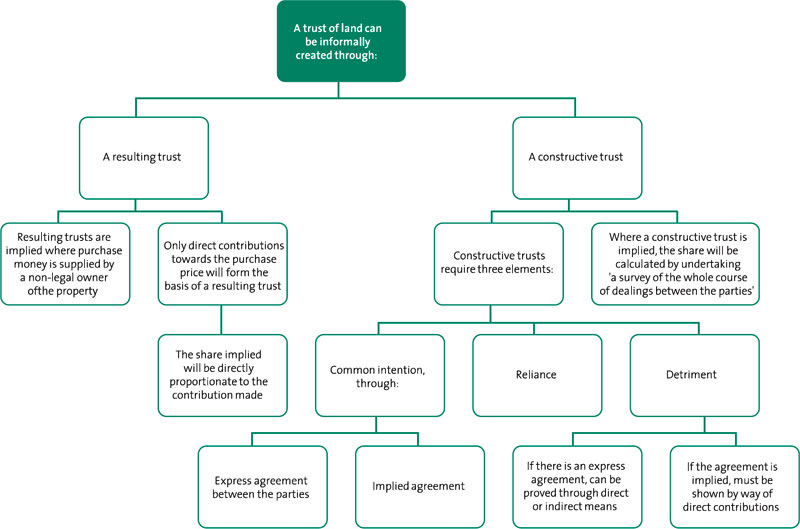Lawyer’s View Surrounding What Is A Constructive Trust Explained
Lawyer’s View Surrounding What Is A Constructive Trust Explained
Blog Article
Introducing the Advantages of a Constructive Count On in Handling Beneficiary Disputes
The idea of a useful trust fund becomes a crucial device in the intricate realm of beneficiary problems, providing a nuanced option to disagreements that usually occur from wrongful property retention. By fostering a fiduciary relationship in between events, this fair treatment not only facilitates quick resolutions but also serves to deter prospective misbehavior. As we explore the diverse benefits of positive depends on, one may begin to examine how these mechanisms can improve the landscape of estate conflicts and contribute to a more fair distribution of properties amongst beneficiaries.
Meaning of Constructive Count On
A useful count on is frequently established by courts to address scenarios where one celebration has actually wrongfully acquired or retained residential or commercial property that truly comes from another (What Is A Constructive Trust). This legal concept is not a standard depend on, as it does not call for the formalities generally related to trust fund development, such as a written contract or the intention of the events involved. Instead, a positive count on arises by procedure of law, functioning as an equitable solution to avoid unfair enrichment
The courts impose a constructive trust fund when it is determined that a person party holds building under scenarios that, in equity and excellent conscience, should not permit them to maintain it. Common scenarios include illegal activities, violations of fiduciary task, or conditions where a celebration has gotten residential or commercial property through inappropriate ways. The constructive depend on therefore operates to secure the rights of the rightful owner by making sure that the residential or commercial property is held for their benefit.
As soon as developed, the constructive count on calls for the event in possession of the home to convey it to the rightful owner, therefore correcting the wrongful circumstance. This device underscores the legal system's commitment to fairness and justice in residential property disputes, emphasizing the significance of honest conduct in ownership and transfer of possessions.
Benefits of Constructive Counts On
Constructive counts on use several substantial advantages in legal disputes entailing residential property civil liberties. Mainly, they act as a fair solution, allowing courts to address situations where an event has actually wrongfully acquired or preserved property that rightfully comes from one more. This develops a structure for justness, guaranteeing that the rightful owner is made up and the unfair enrichment of the offender is curtailed.
Additionally, constructive depends on can speed up resolution in problems over estate properties, therefore minimizing the prolonged and often contentious lawsuits processes related to typical building disputes. Their versatility enables courts to tailor treatments to fit the particular circumstances of each instance, which can bring about even more satisfactory outcomes for all events included.
Additionally, positive counts on advertise openness and accountability amongst recipients and fiduciaries, as they call for the latter to act in the very best rate of interests of the previous. This enhances the honesty of fiduciary relationships, fostering trust fund and participation. By preventing misconduct associated to property ownership, positive counts on add to the overall security of lawful and economic systems, ensuring that residential property rights are appreciated and upheld within society.
How Constructive Counts On Work

In practice, when a positive depend on is enforced, the court identifies the residential property in concern and establishes a fiduciary connection between the parties included. The event who holds the residential property comes to be a trustee, bound to handle it for the benefit of the rightful proprietor, recognized as the beneficiary. This relationship is not based upon a formal contract but instead on the principle of equity, intending to correct situations where one celebration's gain straight associates with another's loss.

Study and Examples
When examining the sensible application of useful counts on, various instance research studies highlight exactly how courts navigate intricate circumstances involving unfair enrichment. One noteworthy situation is * Pettkus v. Becker *, where the Supreme Court of copyright developed a constructive trust fund to remedy the unjust enrichment of one celebration over another in a long-lasting partnership. The court figured out that the contributions of one companion to the acquisition of residential property justified the imposition of a constructive count on, ensuring fair distribution.
Another substantial example is * Gisborne v. Gisborne *, where the court imposed a useful trust fund to deal with the insurance claims of brother or sisters over their dead brother's estate. The court recognized the contributions made by the brother or sisters in keeping the family members residential property, leading to a decision that needed the estate to represent those payments, therefore protecting against unjust enrichment.
These cases exhibit just how positive trusts can effectively deal with conflicts by focusing on fairness and the prevention of unjust enrichment. By examining the specific payments and conditions of the events entailed, courts can apply constructive depend achieve useful source simply results, ultimately enhancing the fair principles underpinning these lawful systems.

Actions to Develop a Constructive Trust
To establish a positive count on, numerous key actions must be followed to make certain that the insurance claim is confirmed and legally acknowledged. The plaintiff has to demonstrate the existence of a fiduciary relationship or a circumstance that calls for the charge of a useful depend on, such as scams, unjustified enrichment, or a violation of task.
2nd, it is important to browse around this web-site collect and existing engaging proof that supports the insurance claim. This consists of paperwork and statements that illustrate the situations resulting in the supposed wrongful retention of building or advantages by the trustee.
Third, the plaintiff must file an application in the ideal court, expressing the grounds for requesting the charge of a useful count on. This petition needs to lay out the specifics of the connection and the unjust enrichment that demands the depend on.
Conclusion
In conclusion, positive counts on stand for an essential fair remedy in the world of beneficiary problems, efficiently attending to wrongful residential or commercial property retention and protecting against unjust enrichment. Eventually, positive trusts promote fairness amongst recipients, ensuring that rightful ownership is preserved and protected.
A constructive depend on is regularly developed by courts to address circumstances where one celebration has actually wrongfully gotten or retained home that truly belongs to an additional.The courts enforce a constructive count on when it is figured out that one celebration holds building under circumstances that, in equity and good conscience, ought to not permit them to keep it. By preventing misbehavior associated to building ownership, positive depends on add to the general security of lawful and monetary systems, making sure that building civil liberties are valued and promoted within society.
In technique, when a constructive trust is enforced, the court determines the home in concern and develops a fiduciary relationship in between the events included. What Is A Constructive Trust. The court identified that the contributions of one partner to the procurement of building warranted the imposition of a constructive trust fund, making sure equitable distribution
Report this page